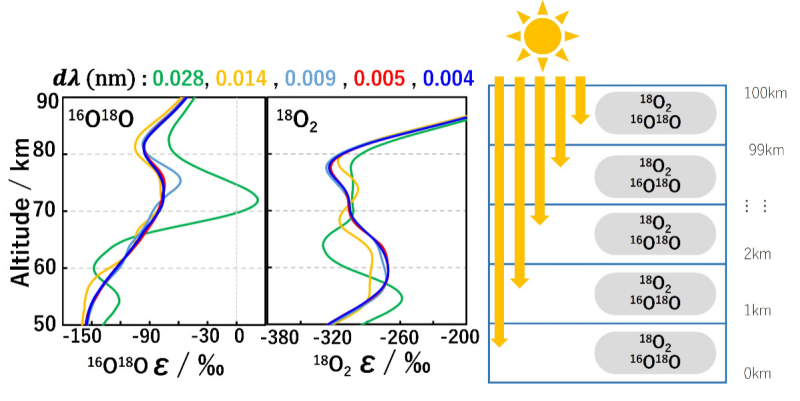
Introducing atmospheric photochemical isotopic processes to the PATMO atmospheric code
ABSTRACT

The study of production and depletion of chemical species is vital for the understanding of composition and evolution of planetary atmospheres. We present an implementation of photoinduced isotopic effects into the PATMO code (Ávila et al., 2021) code designed for the study of stable isotopes and photo-induced isotopic effects. With respect to the original code PATMO, where the photochemistry was not included, this report extends capability of the model to set photochemical processes for stable isotopes and thus enhancing its applicability. The PATMO code is flexible and allows the edition of new chemical reactions without need for hard code them. We also test how changes in spectral resolution affects the calculation of isotopic effects during the photodissociation of oxygen. We found that for a highly structured spectrum such as the Schumann-Runge band a spectral resolution larger than 0.005 nm is necessary for accurately modeling these isotopic effects. We also show that SO2 and SO photodissociation couples in a complex shielding fashion and significantly affects the photo-induced isotopic effects. The model was also benchmarked against today’s Earth atmosphere, where the solar UV flux and the ozone profile of the US Standard atmosphere of 1976 was reproduced with the simple Chapman mechanism and improved with the implementation of NOx and HOx radicals.
KEYWORDS
Keywords: Planetary atmospheres, atmospheric modeling, atmospheric chemistry, stable isotopesSupplementary Materials(file)
https://www.jstage.jst.go.jp/article/geochemj/57/2/57_GJ23004/_supplement/_download/57_GJ23004_1.pdf
- Published : 2023
- Released on J-STAGE : 2023/03/17
- Received : 2022/09/30
- Accepted : 2023/01/03
- DOI : https://doi.org/10.2343/geochemj.GJ23004
- J-STAGE URL : https://www.jstage.jst.go.jp/article/geochemj/57/2/57_GJ23004/_article/-char/en
- J-Online ISSN: 1880-5973
- Print ISSN : 0016-7002
- ISSN-L : 0016-7002
All Issues
- Vol.59, 2025
- Vol.58, 2024
- Vol.57, 2023
- Vol.56, 2022
- Vol.55, 2021
- Vol.54, 2020
- Vol.53, 2019
- Vol.52, 2018
- Vol.51, 2017
- Vol.50, 2016
- Vol.49, 2015
- Vol.48, 2014
- Vol.47, 2013
- Vol.46, 2012
- Vol.45, 2011
- Vol.44, 2010
- Vol.43, 2009
- Vol.42, 2008
- Vol.41, 2007
- Vol.40, 2006
- Vol.39, 2005
- Vol.38, 2004
- Vol.37, 2003
- Vol.36, 2002
- Vol.35, 2001
- Vol.34, 2000
- Vol.33, 1999
- Vol.32, 1998
- Vol.31, 1997
- Vol.30, 1996
- Vol.29, 1995
- Vol.28, 1994
- Vol.27, 1993
- Vol.26, 1992
- Vol.25, 1991
- Vol.24, 1990
- Vol.23, 1989
- Vol.22, 1988
- Vol.21, 1987
- Vol.20, 1986
- Vol.19, 1985-1986
- Vol.18, 1984
- Vol.17, 1983
- Vol.16, 1982
- Vol.15, 1981
- Vol.14, 1980
- Vol.13, 1979
- Vol.12, 1978
- Vol.11, 1977
- Vol.10, 1976
- Vol.9, 1975
- Vol.8, 1974
- Vol.7, 1973
- Vol.6, 1972-1973
- Vol.5, 1971
- Vol.4, 1970-1971
- Vol.3, 1969-1970
- Vol.2, 1968
- Vol.1, 1966-1967




